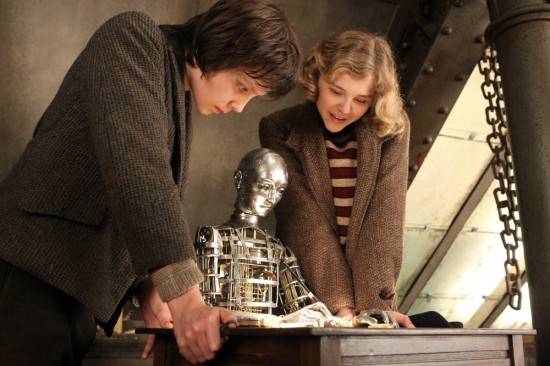 Hugo is a film directed by Martin Scorsese with a screenplay written by John Logan. The film stars Asa Butterfield, Chloë Grace Moretz, Sir Ben Kingsley, Sacha Baron Cohen, Christopher Lee and, briefly, Jude Law. The film centers on a boy named Hugo (Asa Butterfield) who lives and works in 1930’s Paris, France as a clockmaker in a train station. Hugo makes sure that all the clocks in the train station are always in order, but his one ambition in life is to fix a broken automaton that his father was working on, just before he passed away. He believes that if he fixes the broken automaton it will write a message from his deceased father. Hugo finds the last piece needed to fix the automaton when he befriends a local girl, Isabelle (Chloë Grace Moretz), who works in a toyshop with her godfather Papa George (Sir Ben Kingsley). Together, Hugo and Isabelle embark on an adventure to solve the mystery behind the message written by the automaton.
Hugo is a film directed by Martin Scorsese with a screenplay written by John Logan. The film stars Asa Butterfield, Chloë Grace Moretz, Sir Ben Kingsley, Sacha Baron Cohen, Christopher Lee and, briefly, Jude Law. The film centers on a boy named Hugo (Asa Butterfield) who lives and works in 1930’s Paris, France as a clockmaker in a train station. Hugo makes sure that all the clocks in the train station are always in order, but his one ambition in life is to fix a broken automaton that his father was working on, just before he passed away. He believes that if he fixes the broken automaton it will write a message from his deceased father. Hugo finds the last piece needed to fix the automaton when he befriends a local girl, Isabelle (Chloë Grace Moretz), who works in a toyshop with her godfather Papa George (Sir Ben Kingsley). Together, Hugo and Isabelle embark on an adventure to solve the mystery behind the message written by the automaton.
Hugo is one of those rare films that takes the audience on an emotional journey. Asa Butterfield is fantastic in his role as Hugo. The friendship between Isabelle and Hugo is very believable because of how much they love adventure and each other’s company. The emotional core of this film comes from Hugo’s connection to his father, who we see in flashback. Their relationship is sweet and genuine. The sadness Hugo feels is not only a result of his father’s untimely death, but also the loneliness and isolation he feels on a daily basis. In the end, I think Hugo secretly desires to belong somewhere or to someone.
The character that spoke to me most was Isabelle. Throughout the film she is an intrepid explorer who is always ready to help Hugo solve the mysteries that they face. Isabelle is the one character of the film that was confident and sure of her own self worth. I really liked the fact that she was able to stand up to or trick multiple characters in this film, all in the name of a good adventure.
The direction in this film by filmmaker Martin Scorsese is nothing short of amazing. He uses a zoom shot at the beginning of the film to take us through all of Paris, which inevitably leads us to our protagonist. Scorsese worked hard in the film to keep the audience at the center of the action with his protagonist. He always focuses his attention on the action of his characters and never truly uses angled shots. Hugo is in 3D and, while I have distaste for this cinematic film technique, it is used to great effectiveness here. The snow moves toward your face in the opening zoom shot, papers fly when a box is opened, and objects fall towards you when dropped. Hugo is a remarkable experience in 3D. The cinematography by Robert Richardson makes every color in the film purposely bright and inviting, which is especially useful for the scenes that take place in the main part of the train station. The use of light and color makes you feel like you are on an adventure with the characters.
Hugo is Martin Scorsese’s love letter to cinema and he captures our hearts with his first children’s film. This film is proof that movies can enchant.
5 stars.








